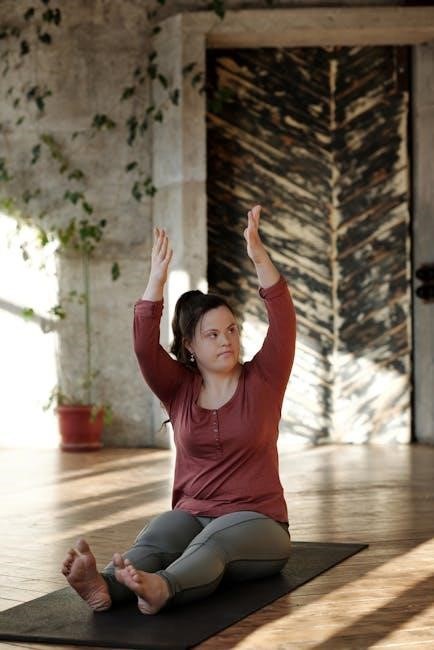Lower cross syndrome is a common postural disorder that affects the lower back and hip joints, requiring specific exercises for correction and relief, using pdf guides.
Definition and Characteristics
Lower cross syndrome is a condition characterized by a specific pattern of muscle weakness and tightness, affecting the lower back and hip joints. This condition is often described as a constellation of postural and muscular changes that occur in a predictable pattern. The characteristics of lower cross syndrome include tightness in the hip flexor muscles and weakness in the abdominal and gluteal muscles. These muscle imbalances can lead to poor posture, lower back pain, and hip joint stress. Understanding the definition and characteristics of lower cross syndrome is essential for developing effective treatment and exercise programs, including those outlined in pdf guides and online resources. Effective management of this condition requires a comprehensive approach.

Treatment Techniques
Treatment involves corrective exercises and stretches to alleviate symptoms and improve posture, using various methods and pdf guides available online daily.
Corrective Stretching and Exercises
Corrective stretching and exercises are essential for alleviating lower cross syndrome symptoms. These exercises target specific muscle groups, such as the hip flexors and lower back muscles. By incorporating exercises like the iliopsoas stretch and pelvic tilts, individuals can improve their posture and reduce muscle imbalances. Additionally, exercises like the bridge and planks can help strengthen the core and gluteal muscles, which are often weak in individuals with lower cross syndrome. Using pdf guides and online resources, individuals can access a variety of exercises and stretches to help manage their symptoms and improve their overall posture and mobility. Regular exercise and stretching can help alleviate pain and discomfort.

Exercises for Lower Cross Syndrome
Specific exercises like pelvic tilts and hip flexor stretches help alleviate symptoms, available in downloadable pdf guides and online resources always.
Strengthening and Stretching Exercises
Strengthening and stretching exercises are essential for managing lower cross syndrome, as they help to improve posture and reduce muscle imbalances.
These exercises can be found in various online resources, including pdf guides and videos, which provide step-by-step instructions and demonstrations.
The exercises typically include a combination of strengthening exercises, such as pelvic tilts and glute bridges, and stretching exercises, like hip flexor and hamstring stretches.
By incorporating these exercises into a daily routine, individuals can help to alleviate symptoms and improve overall mobility and function, it is therefore recommended to start exercising slowly.

Joint Mobilization
Joint mobilization techniques help improve range of motion and reduce stiffness in affected joints, using gentle movements and exercises.
Range of Motion Exercises
Range of motion exercises are essential for improving joint mobility and reducing stiffness in individuals with lower cross syndrome. These exercises involve gentle movements that help to increase flexibility and reduce pain. According to recent studies, exercises such as hip circles and knee lifts can help to improve range of motion and reduce symptoms of lower cross syndrome. By incorporating these exercises into a daily routine, individuals can help to improve their overall mobility and reduce their risk of injury. Additionally, exercises can be modified to suit individual needs and abilities, making them accessible to a wide range of people. Regular exercise can help to improve overall health and wellbeing.

Causes and Risk Factors
Obesity and muscle imbalances are common causes of lower cross syndrome, requiring preventive measures and exercises.
Obesity and Muscle Imbalances
Obesity is a significant risk factor for lower cross syndrome, as excess weight puts additional stress on the lower back and hip joints, leading to muscle imbalances. Muscle imbalances occur when some muscles become overactive and tight, while others become underactive and weak, disrupting the normal movement patterns of the body. This can lead to poor posture, altered movement patterns, and increased risk of injury. The relationship between obesity and muscle imbalances is complex, and addressing both factors is crucial for preventing and managing lower cross syndrome. By understanding the role of obesity and muscle imbalances, individuals can take steps to reduce their risk.
Symptoms and Diagnosis
Lower cross syndrome symptoms include lower back pain and hip joint stress, diagnosed through physical examination and movement assessments, using specific criteria and guidelines.
Lower Back Pain and Hip Joint Stress
Lower back pain and hip joint stress are common symptoms of lower cross syndrome, caused by muscle imbalances and poor posture, requiring specific exercises for relief.
These symptoms can be debilitating and affect daily activities, making it essential to address the underlying causes and develop a comprehensive treatment plan, including corrective stretches and exercises, to alleviate pain and improve mobility, using pdf guides and online resources to support recovery and prevent further injury, and promote overall well-being and quality of life, with a focus on long-term management and prevention of future episodes, through a combination of exercise, education, and lifestyle modifications.
Exercise Programs
Customized exercise programs are essential for correcting lower cross syndrome, using pdf guides and online resources for support and guidance always available online.
Recommended Exercises
Recommended exercises for lower cross syndrome include stretching and strengthening exercises, such as hip flexor stretches and gluteal strengthening exercises, which can be found in pdf guides online. These exercises help to improve posture, reduce pain and discomfort, and increase mobility and flexibility. A well-structured exercise program can help to correct muscle imbalances and improve overall functional ability. It is essential to consult with a healthcare professional before starting any new exercise program, especially if you have any underlying medical conditions or concerns. They can help to design a personalized exercise program that meets your specific needs and goals, using pdf resources and online guides for support. Regular exercise and stretching can help to manage symptoms and improve overall quality of life.
Regular exercise and stretching are essential for managing lower cross syndrome, with pdf guides providing valuable resources and support for treatment and recovery always available online.
Importance of Exercise and Stretching
Exercise and stretching are crucial for managing lower cross syndrome, as they help to strengthen weak muscles and stretch tight ones, improving posture and reducing pain. Regular physical activity can also help to prevent the development of lower cross syndrome in the first place. By incorporating exercises and stretches into daily routine, individuals can reduce their risk of developing this condition and improve overall health and wellbeing. Additionally, exercises and stretches can be tailored to individual needs and abilities, making them accessible to everyone, with pdf guides providing a useful resource for getting started with a new exercise program.

